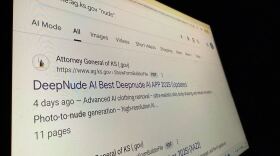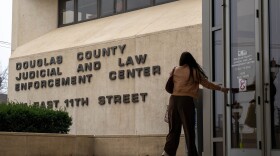-
Work at Wichita's new water treatment plant is on hold because of mechanical failures. The project, now estimated to cost $557 million, broke ground at 21st and Hoover in 2020 and has been plagued with delays.
-
Documents promoting AI deepfakes, money scams and pornography appear under the “ag.ks.gov” domain and dozens of others. The links are now inactive, but the source remains unknown.
-
The Lawrence Old-Fashioned Christmas Parade normally features dozens of human and horse participants from across the region. The Dec. 6 event is now canceled because of the virus outbreak affecting eight states.
-
In Kansas and nationwide, the number of women having babies in their 40s is increasing. It comes as the overall birth rate declines and younger women are having fewer babies.
-
After three years and $6 million worth of renovations, the Kansas Museum of History in Topeka will reopen to the public on Saturday. KPR's Jim McLean got a sneak preview of what's in store for visitors.
-
The families of two transgender teens are asking a state judge to temporarily block the ban on care. That would allow young Kansans to resume hormone therapies and other treatments.
-
Enhanced credits for health insurance purchased from the Affordable Care Act marketplace expire at the end of this year. If they aren’t renewed, premiums will skyrocket for many people in Kansas and nationwide.
-
Wyandotte County Deputy Richard Fatherley is free while he awaits trial in the July 5 death of Charles Adair, who prosecutors say was killed when Fatherly knelt on his back. Fatherley, who faced his first hearing Tuesday, wasn’t required to appear in court in person, which the judge said was standard early in the judicial process when substantive issues aren't heard.
-
There have been thousands of lawsuits by Kansas hospitals in recent years, including many lawsuits for less than $500. One lawsuit was for just $104.
-
The Sedgwick County Sheriff's Office signed a formal agreement with U.S. Immigration and Customs Enforcement to issue 48-hour ICE detainers for people held in the county jail.
© 2025 Kansas Public Radio
91.5 FM | KANU | Lawrence, Topeka, Kansas City
96.1 FM | K241AR | Lawrence (KPR2)
89.7 FM | KANH | Emporia
99.5 FM | K258BT | Manhattan
97.9 FM | K250AY | Manhattan (KPR2)
91.3 FM | KANV | Junction City, Olsburg
89.9 FM | K210CR | Atchison
90.3 FM | KANQ | Chanute
See the Coverage Map for more details
FCC On-line Public Inspection Files:
KANU, KANH, KANV, KANQ
Questions about KPR's Public Inspection Files?
Contact General Manager Feloniz Lovato-Winston at fwinston@ku.edu
91.5 FM | KANU | Lawrence, Topeka, Kansas City
96.1 FM | K241AR | Lawrence (KPR2)
89.7 FM | KANH | Emporia
99.5 FM | K258BT | Manhattan
97.9 FM | K250AY | Manhattan (KPR2)
91.3 FM | KANV | Junction City, Olsburg
89.9 FM | K210CR | Atchison
90.3 FM | KANQ | Chanute
See the Coverage Map for more details
FCC On-line Public Inspection Files:
KANU, KANH, KANV, KANQ
Questions about KPR's Public Inspection Files?
Contact General Manager Feloniz Lovato-Winston at fwinston@ku.edu
Play Live Radio
Next Up:
0:00
0:00
Available On Air Stations










